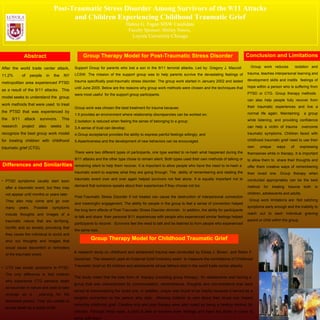
IASWG Poster
- 1. Abstract Group Therapy Model for Post-Traumatic Stress Disorder After the world trade center attack, 11.2% of people in the NY metropolitan area experienced PTSD as a result of the 9/11 attacks. This model seeks to understand the group work methods that were used to treat the PTSD that was experienced by the 9/11 attack survivors. This research project also seeks to recognize the best group work model for treating children with childhood traumatic grief (CTG). Differences and Similarities • PTSD symptoms usually start soon after a traumatic event, but they may not appear until months or years later. They also may come and go over many years. Possible symptoms include thoughts and images of a traumatic nature that are terrifying, horrific and so anxiety provoking that they cause the individual to avoid and shut out thoughts and images that would cause discomfort or reminders of the traumatic event. • CTG has similar symptoms to PTSD. The only difference is that children who experience CTG perceive death as traumatic in nature and seek to take revenge as a yearning for the deceased person. They are unable to accept death as a reality of life. Post-Traumatic Stress Disorder Among Survivors of the 9/11 Attacks and Children Experiencing Childhood Traumatic Grief Hahna G. Fagan MSW Candidate Faculty Sponsor: Shirley Simon, Loyola University Chicago Conclusion and Limitations Group Therapy Model for Childhood Traumatic Grief Support Group for parents who lost a son in the 9/11 terrorist attacks. Led by: Gregory J. Maccoll LCSW. The mission of the support group was to help parents survive the devastating feelings of trauma specifically post-traumatic stress disorder. The group work started in January 2002 and lasted until June 2005. Below are the reasons why group work methods were chosen and the techniques that were most useful for the support group participants. Group work was chosen the best treatment for trauma because: 1.It provides an environment where relationship discrepancies can be worked on; 2.Isolation is reduced when feeling the sense of belonging to a group; 3.A sense of trust can develop; 4.Group acceptance provides the ability to express painful feelings willingly; and 5.Assertiveness and the development of new behaviors can be encouraged. There were two different types of participants, one type wanted to re-hash what happened during the 9/11 attacks and the other type chose to remain silent. Both types used their own methods of talking or remaining silent to help them recover. It is important to allow people who have the need to re-hash a traumatic event to express what they are going through. The ability of remembering and relating the traumatic event over and over again helped survivors not feel alone. It is equally important not to demand that someone speaks about their experiences if they choose not too. Post-Traumatic Stress Disorder if not treated can cause the destruction of interpersonal connection and meaningful engagement. The ability for people in the group to feel a sense of connection helped the long term effects of Post-Traumatic Stress Disorder diminish. In addition, the ability for participants to talk and share their personal 9/11 experiences with people who experienced similar feelings helped participants to recover. Survivors feel the need to talk and be listened to from people who experienced the same loss. A research study on childhood and adolescent trauma was conducted by Elissa J. Brown and Robin F. Goodman. The research used an External Grief Inventory exam to measure the correlations of Childhood Traumatic Grief on 83 children and adolescents whose fathers died in the world trade center attacks. The study noted that the best form of therapy (including group therapy) for adolescents was having a group that was characterized by communication, remembrance, thoughts and conversations that were aimed at memorializing the loved one. In addition, prayer was found to be helpful because it served as a tangible connection to the person who died. Allowing children to vent about their loved one helped minimize childhood grief. Creative arts and play therapy were also noted as being a healing method for children. Through these tools, a child is able to express inner feelings and have the ability to come to terms with them. Group work reduces isolation and trauma, teaches interpersonal learning and development skills and instills feelings of hope within a person who is suffering from PTSD or CTG. Group therapy methods can also help people fully recover from their traumatic experiences and live a normal life again. Maintaining a group while listening, and providing confidence can help a victim of trauma overcome traumatic symptoms. Children faced with childhood traumatic grief need to use their own unique ways of expressing themselves while in therapy. It is important to allow them to share their thoughts and offer them creative ways of remembering their loved one. Group therapy when conducted appropriately can be the best method for treating trauma both in children, adolescents and adults. Group work limitations are: Not catching symptoms early enough and the inability to reach out to each individual grieving parent or child within the group.
Editor's Notes
- Abstract: Currently, nearly 65% of the mentally ill use drugs or alcohol as a means of coping with stressful situations and triggers. This poster describes and assesses a model for an educational support group in which members identify, learn about and practice healthy means of responding to their own high-risk situations. Background: Goals of the group: Model: The group will follow a curriculum for eight sessions, meeting once a week for two hours. Findings: Implications: Relevant Literature: